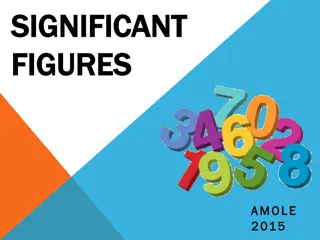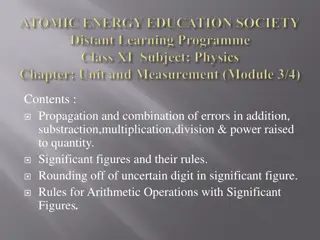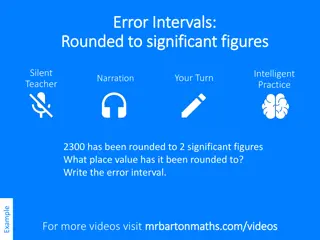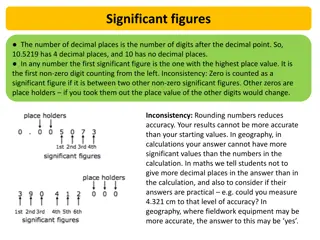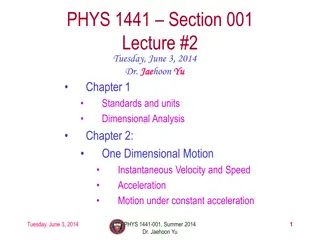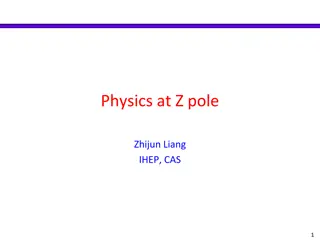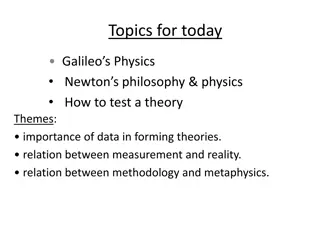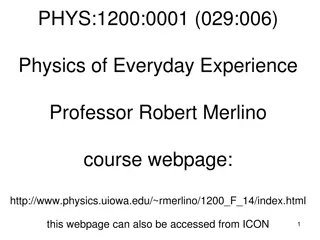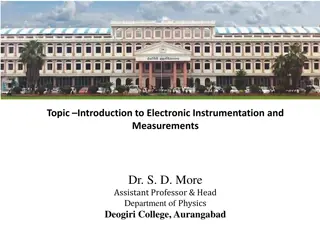Understanding Significant Figures in Physics
Physics is the study of physical things and their properties, emphasizing the importance of measuring and counting accurately. Significant figures play a crucial role in expressing measurement precision, with rules for determining the number of significant figures in a value. Rounding up numbers to the correct significant figure is essential for accuracy in scientific calculations. Scientific notation aids in representing numbers with the desired level of precision, avoiding confusion. Mastering these concepts is fundamental for any student or enthusiast delving into the world of physics.
Download Presentation

Please find below an Image/Link to download the presentation.
The content on the website is provided AS IS for your information and personal use only. It may not be sold, licensed, or shared on other websites without obtaining consent from the author. Download presentation by click this link. If you encounter any issues during the download, it is possible that the publisher has removed the file from their server.
E N D
Presentation Transcript
Lecture 1 Sec (1-4)
What is Physics? Physics is a study of Physical things and their properties. Physical things: things that can be sensed or felt Big system: Sun and earth Atom: invisible, small Watch: visible Time- invisible Laser: visible, radar -invisible Physics study their properties as well Anything in the land and space is physical
Every physical thing need to measured or counted! If you count or measure something, the accuracy of measurement becomes crucial and we have to write the result in significant figures. What is significant figure? Population of KSA in 2009 = 25,391,100 Net worth property of Richest Person in KSA, Al-Waleed bin Talal is: Population of KSA = 25 Million Population of KSA = 25.4 0.1 Million $19.4 Billion (2013) Significant Figure uncertainty
Significant Figures: Measurement of Length Ruler Smallest division = 1 mm 3.1 cm Calipers Smallest division = 0.1 mm 3.16 cm Look at your watch and compare it with stop watch in your smart phone
Significant Figures: Rules (1) All nonzero digits are significant: (4) Trailing zeroes that are also to the right of a decimal point in a number are significant: 1.234 g has 4 significant figures, 1.2 g has 2 significant figures. 0.0230 mL has 3 significant figures, 0.20 g has 2 significant figures. (2) Zeroes between nonzero digits are significant: 1002 kg has 4 significant figures, 3.07 mL has 3 significant figures. (5) When a number ends in zeroes that are not to the right of a decimal point, the zeroes are not necessarily significant: (3) Leading zeros to the left of the first nonzero digits are not significant; such zeroes merely indicate the position of the decimal point: 190 miles may be 2 or 3 significant figures, 50600 calories may be 3, 4, or 5 significant figures. oC has only 1 significant figure, 0.001 0.012 g has 2 significant figures.
Rounding up numbers: Rules Round off rule: If the number after the last significant number is more than or equal to 5 round it off to one higher number but if it is less than 5, keep the same. Example: for 3 significant figure 25.15 Kg = 25.2 Kg (last digit is equal to 5) 25.57 Kg = 25.6 Kg (last digit is Higher than 5) 25.53 Kg = 25.5 Kg (last digit is smaller than 5) Example: for 2 significant figure 25.2 Kg =25 Kg (last digit is less than 5) 25.6 Kg = 26 Kg (last digit is Higher than 5) 25.5 Kg = 26 Kg (last digit is equal to 5) Open the XL page and try the value of Pi.
Scientific Notation: Significant Figure Scientific notation for Significant Figure avoids all confusion. For example, depending on whether the number of significant figures is 3, 4, or 5, we would write 50600 calories as: 4 calories (3 significant figures) 4 calories (4 significant figures), or 4 calories (5 significant figures). 5.06 10 5.060 10 5.0600 10 Population of KSA in 2009 = 25,391,100 Population of KSA scientific notation = 2.5 x 107 ( 2 significant digit) = 2.54 x 107 ( 3 significant digit) = 2.539 x 107 (4 significant digit) Net worth property of Richest Person in KSA, Al-Waleed bin Talal is: $13.3 Billion Scientific notation $1.33x1010
Mathematical Operation: Rules (1) In addition and subtraction, the result is rounded off to the last common digit occurring furthest to the right in all components. Another way to state this rules, it that, in addition and subtraction, the result is rounded off so that it has the same number of decimal places as the measurement having the fewest decimal places. For example, 100 (assume 3 significant figures) + 23.643 (5 significant figures) = 123.643, which should be rounded to 124 (3 significant figures). (2) In multiplication and division, the result should be rounded off so as to have the same number of significant figures as in the component with the least number of significant figures. For example, 3.0 (2 significant figures ) 12.60 (4 significant figures) = 37.8000 which should be rounded off to 38 (2 significant figures). Final Example: (5.00 / 1.235) + 3.000 + (6.35 / 4.0)=4.04858... + 3.000 + 1.5875=8.630829... Answer: 8.6
Some Examples # Examples Scientific notation Computer notation 2.681x102 1 2.681E02 37.76 + 3.907 + 226.4 = 268.1 2.8654x102 2 319.15 - 32.614 = 286.54 2.8654E02 1.32x102 3 104.630 + 27.08362 + 0.61 = 132.32 1.32E02 1.29x102 4 125 - 0.23 + 4.109 = 129 1.29E02 5.0x100 5 2.02 2.5 = 5.0 5.0E0 1.147x102 6 600.0 / 5.2302 = 114.7 1.147E02 8.7x10-1 7 0.0032 273 = 0.87 8.7E-01 (5.5)3= 1.7 x 102 8 9 0.556 (40 - 32.5) = 4 45 3.00 = 1.4 x 102 10 3.00 x 105 - 1.5 x 102= 299850 =3.00 x 105 Subtracted number is smaller than error 11
Three fundamental physical quantities Fundamental Quantities Length [L] International Standard (SI) Units Meter (m) Mass [M] Kilogram (Kg) Time [T] Second (s)
Changing Units: Time 1 min = 60s 60 s 1 min = 1 = 1 1 min 60 s Change s to min Change min to s 4531 s 4531 min = 4531 s x 1 = 4531 min x 1 1 min 60 s = 4531 s x = 4531 min x 60 s 1 min = 45.31 min = 271860 s = 2.7186 x 105 s
Changing Units: Length (Distance) 100 cm = 1 m 100 cm 1 m = 1 = 1 1 m 1 00 cm Change cm to m Change m to cm 4531 cm 4531 m = 4531 cm x 1 = 4531 m x 1 1 m 100 cm = 4531 cm x = 4531 m x 100 cm 1 m = 45.31 m = 453100 cm = 4.531 x 105 cm
Conversion to Meter Metric System British System Factor Name Symbol Terra meter Giga meter Mega meter Kilometer Meter Centimeter Millimeter Micrometer Nanometer Pico meter 1024 yotta Y 1 mile = 1760 yards 1 mile = 8 furlong 1 furlong = 10 chains 1 chain = 4 rods 1 rod = 5 1/2 yards 1 yard = 3 feet 1 foot = 12 inches 1021 zetta Z 1018 exa E 1015 peta P 1 inch = 2.54 cm 1 mile = 1609 m 1012 tera T 109 giga G 106 mega M 103 kilo k 102 hecto h 101 deka da Convert 4531 feet to meter 10-1 deci d 10-2 centi c 4531 ft 10-3 milli m 10-6 micro 12 in 2.54 cm 1 m 10-9 nano n x x = 4531 ft x 10-12 pico p 1 ft 1 in 100 cm 10-15 femto f = 1381.049 m 10-18 atto a 10-21 zepto z 10-24 yocto y Test: Convert 4531 rod to nanometer
Changing Units: Mass 1000 g = 1 Kg 1000 g 1 Kg = 1 = 1 1 Kg 1 000 g Change g to kg Change Kg to g 431 g 431 Kg = 431 g x 1 = 431 Kg x 1 1 Kg 1000 g = 431 g x = 431 Kg x 1000 g 1 Kg = 0.431 Kg = 431000 g = 4.31 x 105 g
Conversion to Kg British System Metric System 1 ton = 20 cwt 1 ton = 2240 lb. 1 ton = 1.12 US ton 1 cwt = 4 quarters 1 quarter = 2 stone. 1 stone = 14 lb. 1 lb. = 16 oz. 1 oz. = 16 drams 1 oz. = 437.5 grains 1 US ton = 2000 lb. Terra gram Giga gram Mega gram Kilogram Gram miliigram Microgram nanogram 1 lb = 453.6 g 1Kg = 2.2 lb Convert 5301 oz (aunce) to milligram 5301 oz 1 lb 453.6 g 1000 mg x x = 5301 oz x 16 oz 1 lb 1 g = 1.5 x 108 mg Test: Convert 5301 ton to oz
Changing Units: Time 60s = 1 min 60 s 1 min = 1 = 1 1 min 60 s Change s to day Change min to s 720 s 720 min = 720 s x 1 = 720 min x 1 1 min 1 hr 1 day 60 s = 720 s x x x = 720 min x 60 s 60 min 24 hr 1 min = 43200 s = 0.431 day = 4.32 x 104 s
Exercises: Ex1. Speed of a car is 2800 cm/s, find the speed in mi/hr 1 mile = 1609 m = 2800 cm/s 1 m 1 mi = 2800 cm/s x x 100 cm 1609 m 60 s 60 min x x = 0.017 mi/s 1 min 1 hr = 62.6 mi/hr VVIP Question Practice Many times Ex2: Density of a body is 2800 lb/ft3, find the Density in Kg/m3 1 lb = 453.6 g 1 ft = 12 in 1 in = 2.54 cm
Lecture 2 Sec (5-7)
What do I mean by fundamental? Concrete Bricks Rod You can build anything out of building blocks!
Three fundamental physical quantities Fundamental Quantities Length [L] International Standard (SI) Units Meter (m) Mass [M] Time [T] Kilogram (Kg) Second (s)
One Dimension: Length or Distance Length of a rope = l = L Distance/displacement = s = L l Numbers and has no dimension r Circumference of a circle = 2 r = L Perimeter of a rectangle = 2(l+b) = L b Do not add or subtract dimensions l
Tow Dimension: Area Area of a Rectangle (A) = l.b = L.L = L2 Area of a square (A) = l.l = L.L = L2 Area of a circle (A) = r2 = L2 Area of a triangle (A) = (1/2)base . height = L2 h b Surface Area of a sphere/ball (A) = 4 r2 = L2
Three Dimension: Volume Volume (V) = base Area. Height = L2.L = L3 Volume of a box (V) = l.b.h = L.L.L = L3 Volume of a sphere/ball (V) =(4/3) r3 = L.L.L = L3 Volume of a cylinder (V) = r2.h= L2.L = L3
Mixed Dimensions-I Mass M = ML-3 = Density ( ) = Volume L3 displacement L Velocity (v) = = LT-1 = time T distance L Speed (v) = = LT-1 = time T Velocity change L/T Acceleration (a) = = LT-2 = time T Mass . velocity = m . v = MLT-1 Momentum (p) =
Mixed Dimensions: II mass . acceleration = m . a = MLT-2 Force (F) = Force MLT-2 Pressure (P) = = M L-1T-2 = Area L2 displacement . force = L MLT-2 = ML2T-2 Work/Energy (W/E) = displacement x force = L MLT-2 = ML2T-2 Torque(T) = Work ML2T-2 = M L2T- Power (P) = = Time T 3 Mass .(distance)2 = ML2 Moment of Inertia (I) =
Dimensional Analysis I at v v + = 0 L T T ..... L L = T 2 T Question 1: Find the dimension of a in above equation! t v s + = 2 at 1 0 2 L L L = 2 ..... T T 2 T T Question 2: Find the dimension of a in above equation! v v 0 + = 2 2 2 as 2 2 L L L = ..... L 2 2 2 T T T Question 3: Find the dimension of a in above equation!
Dimensional Analysis II Question 4: Prove through Dimensional analysis F pressure = = density g = acceleration due to gravity h = height = gh A Question 5: Prove through Dimensional analysis p = change in momentum m = mass r = radius V = velocity 2 p mv = = = Force ma t r Question 6: Find the dimension of G . M = mass m = mass r = distance Mm Force = G 2 r Question 7: Work (W) Potential Engery (PE) and Kinetic Energy (KE) have the same dimension . mgh PE = = W s F s = displacement = 2 KE mv 1 2 Question 8: prove through dimensional Analysis W power = = Fv t
Dimensional Analysis III Question 9: Find the value of x, y and z = = density g = acceleration due to gravity h = height x y z pressure g h Question 10: Find the value of x, y and z m = mass r = radius v = velocity Force= x y z m v r Question 11: Find the value of x and y T= Time Period l = length g= acceleration due to gravity = 2 xg y T l Question 12: Find the value of x and y = density B = Bulk modulus (Force/Area) = xB y v Question 13: Find the Dimension of A and B = + 2 y At Bt (1) y= displacement t = time = + 2 y At ABt (2)
Few Examples Old Exams 091-Q1. Consider a cube of iron of mass 8.0 kg and side 4.0 inches. What is its density in kg/m3? (1 inch = 2.54 cm) A) 7.6 103 B) 6.9 103 C) 9.8 103 D) 4.3 103 E) 10 103 T 101-Q2. The mass of a piece of card board is 20 g. Its length and width are 8.0 and 3.0 inches, respectively. If the thickness of the card board is 0.50 mm, what is the density of the card board in kg/m3? (1 inch = 2.54 cm) A) 2.58 103 B) 1.67 10 2 C) 1.67 x 10 3 D) 2.58 x 10 4 E) 2.45 x 105
Few Examples Old Exams T82-Q1. Iron has a density of 7.87 g/cm3. What is the mass of an iron block having a volume of 2 in3 ? (1 in = 2.54 cm) A) 0.26 kg B) 0.33 kg C) 0.55 kg D) 0.76 kg E) 0.13 kg 092-Q2. Gold has a density of 19.3 g/cm3. If a sample of gold of mass 30.5 g is pressed so as to make a sheet of 1.00 micrometer thickness, what is the area of the sheet? (1 micrometer = 10 6 m) A) 1.58 m2 B) 3.05 m2 C) 2.45 m2 D) 5.32 m2 E) 10.5 m2
Few Examples Old Exams 092-Q1. The force F applied on a particle is given by the relation F = K A B2, where K is a dimensionless constant, is a density and A is an area. Find the dimension of B. A) L/T B) L2/T2 C) T/L D) T2/L2 E) M/T T82-Q2. The speed of sound v in a fluid depends upon the fluid density and its bulk modulus B as follows: v = n Bm. Using dimensional analysis, find the values of constants n and m, respectively. The unit of density is kg/m3 and that of bulk modulus B is kg / (m.s2) A) -1/2, +1/2 B) -1/2, -1/2 C) +1/2, -1/2 D) +1/2, +1/2 E) - 1, + 1
Few Examples Old Exams T101 091-Q2. Consider the following physical relation: M = C arb, where M is mass, is density, r is distance and a and b are exponents. C is a dimensionless constant. What are the values of a and b so that the equation is dimensionally correct? A) a = 1 and b = 3 B) a = 1 and b = 2 C) a = 2 and b = 2 D) a = 2 and b = 1 E) a = 3 and b = 1
Two rods are made of the same material. Girder A is 5 times longer than the rod B and has a cross-sectional area 6 times greater than B. What is the ratio of the mass density of rod A to the mass density of rod B? Ch1: 25: Iron has a density of 7.87 g/cm3 and the mass of an iron atom is 5.1 x 10-26 Kg. If the atoms are spherical and tightly packed, a) what is the volume of an iron atom? b) What is the distance between the centers of two atoms? c) How many number of atoms can be in 1cm3?
T81-Q1. What is the height of a 2.913 kg solid gold cylinder whose radius is 2 cm? The density of gold is 19.32 g/cm3. (Ans: 12 cm) T072 : Q1.: The position y of a particle moving along the y axis depends on the time t according to the equation y = At2 +Bt. The dimensions of the quantities A and B are respectively: (Ans: L/T, L/T2) T071: Q1.: A swimming pool is filled with 16,500 ft3of water. What is the volume of water in m3? (12 inch = 1 ft and 2.54 cm = 1 inch). (Ans: 467 m3) T071: Q2.: The position x of a particle is given by , x = Bt2 +(C/B) t where x is in meters and t is in seconds. The dimension of C is: ( Ans: L2/T3 ) T062: Q1: From the fact that the average density of the Earth is 5.50 g/cm3 and its mean radius is 6.37 106 m, the mass of the Earth is: (Ans: 5.95 1024 kg ) T052:Q1. A nucleus of volume 3.4 x 10 3 fm 3 and mass of 1.0x 10 2 u has a density of: (1 fm = 10-15 m, 1 u = 1.7 x 10-27 kg) (Ans: 5.0 1016 kg/m 3) T041:Q1 .1 shake = 10-8 seconds. Find out how many nano seconds (ns) are there in 1 shake.(1 nano = 10-9) (Ans: 10 ns ) T41-Q2: A drop of oil (mass = 0.90 milligram and density = 918 Q0 kg/m**3) spreads out on a surface and forms a circular thin film of radius = 41.8 cm and thickness h (see Fig 8). Find h in nano meter (nm). (1 nano = 10**(-9)) (Ans:1.8 nm ) T991:Q2 How many molecules of water are there in a cup containing 250 cm3 of water? Molecular mass of H2O = 18 g/mole; Density of water = 1.0 g/cm3; Avogadro s number = 6.02 x 1023 molecules/mole (Ans: 8.4 x1024)
Ch1-Q7:Antarctica is roughly semicircular, with a radius of 2000Km. The average thickness of it s ice cover is 3000m. How many cubic cm of ice does Antarctica contain? (ignore the curvature of earth) Volume (V) = A x h Area of circle = r2 Area of semicircle (A) = ( ) r2 V = ( ) r2 x h 2 1000m 100cm 100cm ( ) = 9 . 1 = 22 V 2000 Km 3000m 10 cm 1Km 1 1 m m
Ch1-39: A cord is a volume of cut wood equal to a stack 8 ft long, 4 ft wide, and 4ft high. How many cords are in 1.0 m3 ? 1 m 8 ft v 1 m V 4ft 1 m 4ft 1 ft = 12 inches 1 inch = 2.54 cm Volume = A x h = l x b x h Nv = V N = V/v -2 -2 -2 12 in 2.54 cm 10 12 in 2.54 cm 10 12 in 2.54 cm 10 m m m = v 8ft 4ft 4ft 1ft 1 cm 1 1ft 1 cm 1 1ft 1 cm 1 in in in v = 3.6 m3 N = 0.3
Ch1:50- A unit of area often used in measuring land areas is the hectare, defined as 104 m2. An open pit cold mine consumes 75 hectares of land, down to a depth of 26 m, each year. What volume of earth in cubic Km3 is removed in this time? 75 x 104 m2 26 m Volume (V) = Area x depth 3 3 10 ( ) Km = = 4 3 3 V 75 10 26 . 0 02 m Km 3 1 ( ) m


